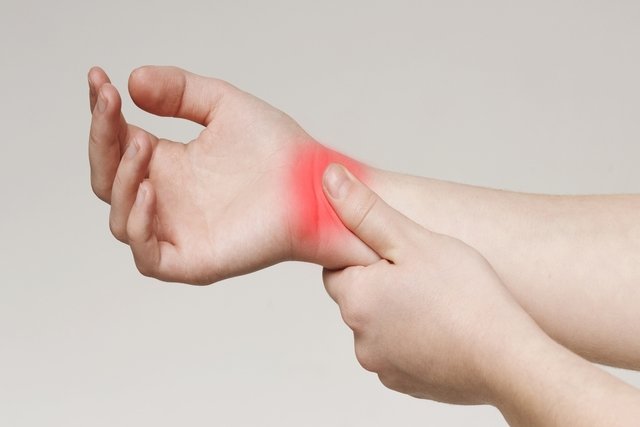Tendonitis treatment for mild injuries mostly involves resting the affected joint and applying an ice pack for about 20 minutes 3 to 4 times a day.
However, treatment that does not improve after a few days, should be assessed by an orthopedic surgeon. The doctor may prescribe anti-inflammatory or analgesic medications as well as immobilization.
In some cases, it may also be necessary to undergo physiotherapy, which may use equipment such as ultrasound, exercises or massage to treat tendon inflammation. In more serious cases, when the injury does not improve with the prescribed treatment and physiotherapy or when the tendon ruptures, surgery may be advised.

Treatment options
Treatment for tendinitis that your orthopedic surgeon, family doctor or physiotherapist may recommend involves:
1. Tendinitis remedies
The main medications that may be indicated for tendonitis are:
- Anti-inflammatories and analgesics, for 7 to 10 days, to relieve pain and swelling. Before taking the pill, it is also advised to take a gastric protector, such as omeprazole, to protect the walls of the stomach, and prevent gastritis caused by the medicines;
- Anti-inflammatory and analgesic ointments, which should be applied 3 to 4 times a day in the exact location of the pain, massaging lightly until the skin absorbs the product;
- Injectable corticosteroids, in cases where the use of anti-inflammatories is not sufficient, to more quickly relieve pain and inflammation. It is important that the injections are administered as per the doctor's prescription. 1 to 2 injections may be recommended with an interval of 4 to 6 months.
It is important that medications are taken as prescribed by the doctor.
2. Home remedies
A great home treatment for tendonitis is applying ice packs, as cold therapy can help relieve pain and inflammation. To make ice packs, simply wrap some ice cubes in a thin towel to make a small bundle and let it rest on the affected area for up to 20 minutes at a time.
Initially, cold packs may cause some discomfort, but this should resolve within approximately 5 minutes. This can be done approximately 3 to 4 times a day in the initial phase of treatment, in the first few days, and 1 or 2 times a day when symptoms start to subside.
3. Immobilization
Immobilization may be necessary in some situations, such as:
- There is increased sensitivity at the site
- Pain only occurs when carrying out an activity and interferes with work or activities of daily living
- There is swelling at the site
- Muscle weakness
Therefore, using a splint to immobilize the painful joint can help reduce movement, helping to alleviate pain and inflammation.
However, using the splint for a long time or frequently can weaken the muscles, which contributes to worsening tendonitis, so it is important to follow the orthopedist's instructions.
4. Physiotherapy
Physiotherapy treatment for tendinitis can be done using techniques such as ultrasound, cold therapy, massages, stretching and muscle strengthening exercises. The aim of physio is to relieve pain and inflammation of the affected tendon and to maintain movement and strength of the affected muscles.
Ultrasound can be performed using just the gel or a mixture of this gel and an anti-inflammatory gel such as Voltaren. However, not all ointments can be used in this way, because they can prevent the penetration of ultrasound waves and prevent their effect.
Physiotherapy sessions can be carried out daily, 5 times a week, or according to the person's availability. However, they should be as consecutive as possible to ensure a cumulative effect.
5. Platelet-rich plasma
Platelet-rich plasma is a treatment that involves collecting a blood sample, which is then centrifuged to separate the platelets. The platelets are then injected into the affected area to help the injured tissue recover faster, as platelets release substances known as growth factors.
6. Surgical repair
Surgery for tendonitis is indicated when
- Other treatments have not been effective
- When the tendon ruptures
- Calcium crystals are deposited at the site, making it necessary to scrape or sew the tendon after it ruptures.
The surgery is relatively simple and recovery does not take long. The person must spend around 5 to 8 days with a splint after surgery and, once cleared, the person can return to a few more physiotherapy sessions to ensure a full recovery.
How to prevent flare-ups
To prevent tendonitis from flaring back up, it is important to identify what caused it. The causes can vary from repetitive movements during the day, such as typing on a computer keyboard or cell phone or holding heavy weights for prolonged periods.
This type of excessive effort at once or repetitive movements lead to tendon inflammation and, consequently, localized pain near the joint.
Therefore, to cure tendinitis and prevent it from reappearing, these situations should be avoided. Be sure to take breaks from work and avoiding excessive physical activity, For those who work in a sitting position, good posture at work is also important to prevent muscle contractures and joint overload.
